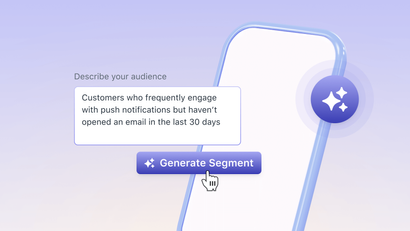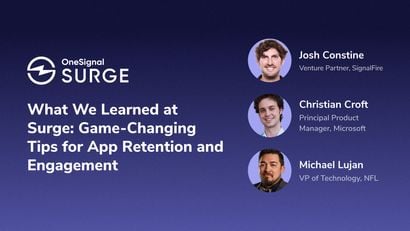What is first-party data?
First-party data is information your company collects and aggregates on your customers through your owned platform and systems.
In a data-driven marketing space, it’s important to understand the differences between zero, first, and third-party data, the regulations that surround each, and importantly, which types of data you should be prioritizing in your strategy in order to optimize your business.
In short, collecting first-party data serves to create a fuller picture of your customer to cater to in your In marketing and product development efforts.
What is considered first-party data?
First-party data includes any data you collect directly on your customer .
This type of information can include product interactions, transactions, behavior, and more. Here are some categories of first-party data brands can collect on their customers.
- Web Browsing Activity
- Email Engagement Data
- Push notification CTR’s
- Social media data
- Product interactions
- Offline data such as name and email
First, Second, and Third-Party Data
Second-party data is the same type of information as first-party data, but rather than receiving this data directly from the customer, your business instead acquires it through a partner. In other words, second-party data is shared, rather than sold.
Second-party data can be valuable to your marketing and communications strategy, because it helps you fill in the gaps you have in your current understanding of your users/customers.
First-Party vs Third-Party Data: What’s the Difference?
While first-party data is derived from the direct relationship between a customer and a brand and second-party data is shared through a partner, third-party data is purchased from a third entity.
Third-party data is typically collected and sold to businesses by another entity, such as the high-profile giants Facebook and Google.
Businesses have historically purchased third-party data to leverage in marketing and advertising. Statista found that 22 billion dollars were spent on third-party data in 2021.
However, over the past several years, a series of privacy changes have shifted away from third-party data and toward first-party data.
Privacy Regulations such as the GDPR and the CCPA are written to protect consumer data and provide transparency and consent frameworks around the types of data collected, how you’ll use it, and who you’ll share it with. These policies have introduced more stringent precedents for privacy on a global level, which have contributed to the shift towards first-party data.
With today’s policies in place, leveraging First party data makes it easier to adhere to the consent frameworks proposed by both the GDPR and the CCPA.
Google’s Third-Party cookies Ban and First-Party Data
A significant reason the ecosystem is shifting away from third-party data use is on account of Google’s groundbreaking third-party cookies ban.
in 2020, Google announced it would phase out third-party cookies on Chrome. Chrome would end support for third-party cookies near the end of 2023.
As Chrome holds 65 percent of the browser market, Google’s decisions around privacy historically set an industry precedent.
As part of the tech giant’s Privacy Sandbox initiative, which aimed to address privacy concerns, the company also announced a new advertising framework called the Federated Learning of Cohorts.
Without the wealth of data that third-party cookies has provided marketers and advertisers, professionals in the marketing and advertising fields must now leverage zero and first-party data in order to achieve the level of behavioral targeting they were able to before.
With more stringent regulations on advertising frameworks, businesses are increasingly relying on the likes of first and second-party data to optimize their customer experiences.
They are also increasingly leveraging other outreach channels, such as push notifications, email, and SMS that don’t require third-party cookies.
As the marketing ecosystem shifts away from third-party advertising, first-party data becomes even more important, as companies change their focus to user retention and Lifetime Value (LTV) rather than paid advertising.
First-Party Data Collection
By collecting first-party data, you can not only optimize both internal and external business processes but also enhance the value of your customer interactions.
Meeting Customer Expectations
With ever-increasing customer expectations, it’s much more important to collect data to help you personalize your customer experience and stand out among your competitors.
McKinsey & Company found that 71 percent of respondents “expect personalization” from brands and businesses and 76 percent “get frustrated” when this expectation is unmet.
Personalizing Content
34 percent of consumers are more likely to purchase based on personalized content, making first-party data much more relevant for your campaigns.
First-party gives you valuable insights into user behavior and analytics — ranging from how users interact with your site, app, or service, all of which allow you to better personalize messaging to your users’ desires and solve their pain points.
Driving Retention and Revenue
Data-driven product development and marketing approaches more effectively translate to getting more leads into the funnel, retaining users throughout their lifecycle, and ultimately delivering the value they are looking for.
First-party data is also more cost-effective than third-party data, because you collect it directly from users rather than purchasing it. This makes it even more efficient within your company’s overall marketing budget.
How to Use First-Party Data to Personalize Customer Communication
First-party data is useful for a variety of marketing use cases, from transactional to marketing messages. First-party data is the backbone of your message personalization efforts.
From leveraging user behavior across your website and app to your customer’s interactions with your omnichannel messaging campaigns, there are endless possibilities when it comes to the ways you can use first party data for a tailored and heightened customer experience.
Using First-Party Data in Marketing Messages
For instance, let’s say you see that a user has purchased three beauty products from your online store. This first-party data can inform a cross-sell marketing email sequence retargeting this user with complementary products in the beauty category.
Blue Wizard Uses First-Party Data to Drive Purchases
Our gaming client Blue Wizard is a web-based gaming company that monetizes its model based on in-game purchases.
Blue Wizard targets segments of players who’ve previously bought in-game currency based on segments they’ve created using first-party data they’ve collected through OneSignal’s web SDK.
They can then appropriately retarget these high spenders (who comprise ten percent of their user base) and creates messaging campaigns to entice these top spenders to purchase other objects.
Using First-Party Data in Transactional Messages
First-party data can also inform vital transactional messaging campaigns, such as security-related messaging. Our client Bitcoin.com, for instance, uses first-party data to inform a variety of their transactional use cases, such as communicating the execution of a crypto transaction. They send the messages at scale with user data collected by OneSignal.
“When a person sends some significant amount of crypto, they wait patiently to get an alert about that…it’s crucial functionality and we love to avoid any manual work here.”
Get Started with OneSignal
Marketing automation software providers offer their users a way to track interactions with their campaigns, provide integrations with leading customer data platforms, and further hone companies’ targeting approach in the wake of privacy changes and an increased focus on first-party data, all while aggregating data in a single, centralized dashboard. To try our solution, sign up for a free account today.
Get Started for Free



